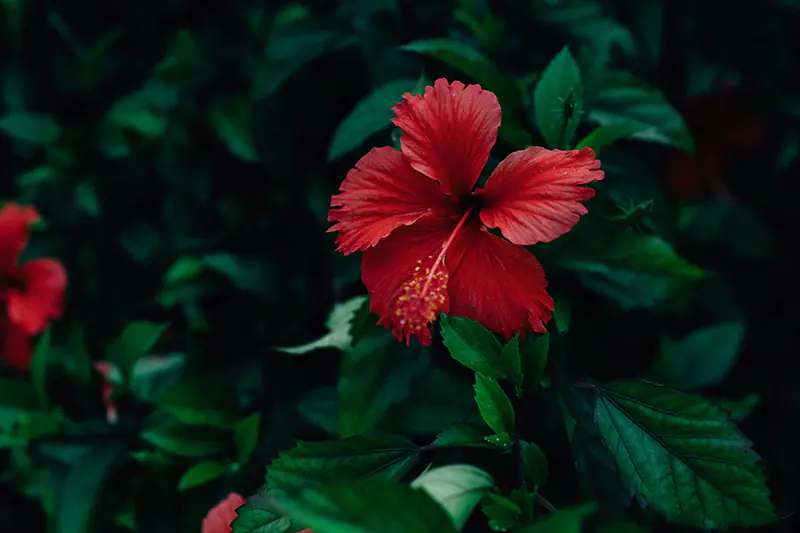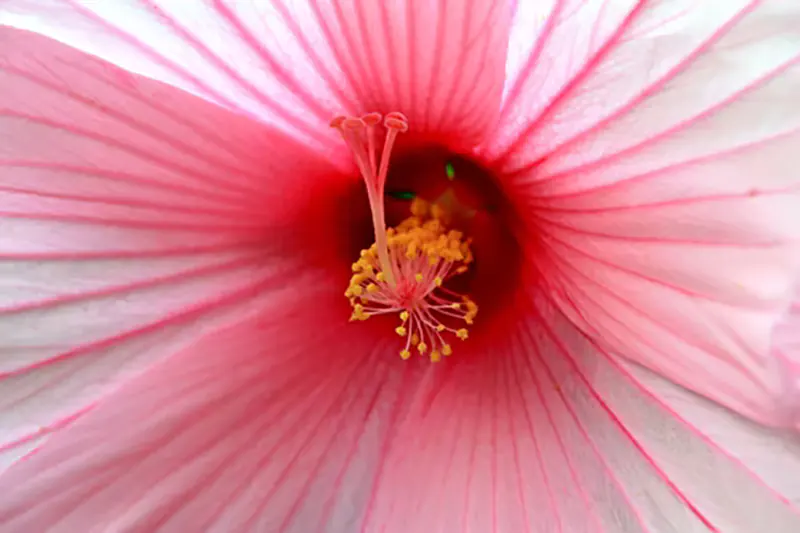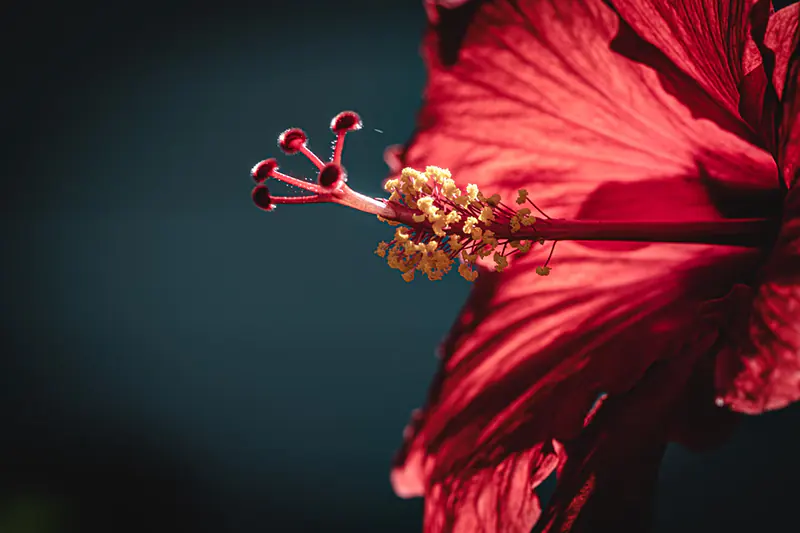How to Keep Hibiscus in Bloom
Hibiscus is the natural-born star of any tropical gardenscape. If you have one of these stunners in your garden, you no doubt prefer when they’re in full bloom, boasting an awe-inspiring colorful display. But hibiscus doesn’t naturally keep its brilliant plumage through every season. Even the perennials that never seem to die back still lose their luster in the off-seasons.
This article will explore all the different ways to keep your hibiscus in bloom as much as possible. I’ll also address the various factors that lead to peak flower production and errors I’ve noticed in hibiscus care regimens that are sure to slow down and even stunt flower production. By the end of this article, you’ll have all the information you need to ensure your hibiscus is in full bloom year-round.

Why Does Hibiscus Bloom?
It’s easy enough to answer the question ‘how to keep hibiscus in bloom’ without going into the mechanics of flowers and why they bloom in the first place. However, I like context. And I like giving readers context. Your hibiscus isn’t blooming because it can; there are actual reasons why this blooming and flower production mechanic exists and why it matters so much in the natural world. This section will explore that mechanic in detail.
The Purpose of Flowers
If you find yourself at a nursery, as I often do, you likely evaluate a plant’s suitability for your garden based on how it looks. We all have our favorites. Mine, for instance, are unsurprisingly hibiscus and bougainvillea. But even within those two genera, I have favorite species and colors. I’d, for instance, much rather have an orange hibiscus than a red one. My point here is that we judge flowers based on their color and, more often than not, use them to beautify our spaces to our specifications. Whether you use them as centerpieces for tables or as statement pieces in your garden, we value flowers like hibiscus primarily for their beauty.
The natural world sees them differently. Flowers are an essential mechanism in the reproduction of flowering plants. Everything about the hibiscus’ spectacular floral displays is purpose-built to help facilitate pollination, seed production, and seed dispersal.
The petals of your hibiscus flower are collectively known as the corolla. Just below the petals, you usually have what look like green fleshy petals. These are known as sepals and are collectively called the calyx. The calyx and corolla together make up the perianth, the head of the flower.
The corolla is crucial to reproduction because that is what ultimately attracts pollinators to hibiscus. Now, it’s important to mention that hibiscus is one of the few flowering genera that can self-pollinate. However, a great deal of pollination still relies on external pollinators such as butterflies, hummingbirds, and bees.

Hibiscus and Color
Color is a fascinating topic when it comes to flowers. This is because while the colors we see are absolutely incredible, pollinators don’t always see them the same way.
The colors we see are essentially pigments that are a result of genes within the DNA of plants. How this works is that these pigments absorb vast amounts and shades of color and reflect a few other shades. The petals of a red hibiscus rosa-Sinensis, for example, absorb all the colors in the light spectrum apart from red. The pigments in their petals reflect red light particularly, and thus that is the color that our eyes are able to detect.
Bees, butterflies, and most birds see the world primarily through ultraviolet vision. There are some people with conditions that allow them to see the light in this part of the spectrum as well. But overall, ultraviolet light is just out of the perception range of most humans.
Not all flowers have ultraviolet markings, but a great many of them do. From my research, it appears as though hibiscus does indeed have these markers. But if pollinators, the very creatures these flowers depend on for survival, can’t see all the beautiful colors we do, what is the point of them? Why do they exist?
Colors can actually carry over vast amounts of data to the pollinators. For instance, hibiscus sometimes gets duller with age. Their colors appear to fade and sometimes even experience a change in hue completely. This is most likely to alert pollinators that they are past their prime. Therefore, if a bee, butterfly, or hummingbird sees a hibiscus flower that is toward the duller side of the color spectrum, even as represented in ultraviolet shades, they know that that particular flower is not likely to contain nectar nor is it likely to be able to reproduce any longer. This is an interesting mechanic and almost confirms the idea that nature is permanently communicating amongst itself, even if concepts are expressed in languages we don’t understand.
There’s another argument for why colors exist on flowers like hibiscus in the first place. That argument is us. Some scientists theorize that plants have adapted to our presence in their space. Through many generations, they’ve made the connection between how beautiful a particular plant is and how likely we are to propagate it. This idea holds water. As I pointed out before, when we visit a nursery, which flower are we more likely to take home and cultivate? A dull, colorless one, or a vibrant, luminescent one that could turn our garden into a celebration of the beauty of the natural world? Time and time again, I choose the brightest, most colorful flowers for my own cultivation efforts.
Why Does Reproduction Matter?
This seems like a silly question, but it’s far more interesting than most might think. The obvious answer here is that plants like hibiscus reproduce in order to make more of themselves.
One thing not everyone knows is that even in the plant kingdom, time is a finite concept. Plants don’t live forever.
There are two main types of hibiscus plants; tropical and hardy. Both varieties are technically perennial, but tropical hibiscus sometimes skews more toward the annual side. Annual here means that they only live through one growing season. When that season is over, the plant begins to die. Perennials live for up to 50 years in many cases and produce flower after glorious flower throughout their entire lifecycle. Perennials sometimes look as though they are dead, but underneath the dry leaves and dead flowers, their internal structure is still green and simply waiting for the next growing season.
This finite lifespan means that the hibiscus has a limited time within which to reproduce. And reproduction ensures the survival of the species.
As the world changes, climates shift, and ecosystems are subject to factors that alter their landscapes forever. In such a mutable world, plants like hibiscus need to adapt to various environments in order to survive. Part of this adaptation lies in reproduction. Reproduction is a massive transfer of data. All of the information a plant has gleaned from growing in a specific environment is passed on in the form of fertilized seeds. This allows the resulting hibiscus plant to have a genetic predisposition to the environment the parent plants thrived in. This way, each new generation of hibiscus plants doesn’t need to struggle as much to establish themselves, as long as the environment doesn’t change too rapidly.
The ultimate reason why all of this matters is because plants occupy such a pivotal space within the circle of life. If you allow hibiscus to die out completely, there’s no telling what kind of impact it could have on the world as a whole. Nothing is separate; everything is part of an interconnected tapestry of organic beauty.
Factors Affecting Flower Production
There are numerous factors that affect how well your hibiscus will flower. Understanding each of these factors is the only true way to get the best out of your hibiscus’ flowering season. If you know what needs aren’t being met, you know what you need to add or take away in order to get your hibiscus blooming again. Below, we’ll discuss all of the factors that influence how vivaciously and vibrantly your hibiscus blooms.
Water
Hibiscus is remarkably tolerant of drought-like weather and should still grow if it goes without water for a while. However, regular watering will prolong the flowering season of your hibiscus. The main thing here is that the nutrients that the hibiscus needs can only be absorbed in a soluble form, so they can’t be absorbed without water. This is the prime reason why water is so important.
One thing I’ve noticed people doing, which is definitely in contrast to what your plant needs, is watering hibiscus when they see it start to wilt. A plant that is wilting is a plant that has already gone too long without water. You should give your hibiscus a good long soak once a week for peak flower production and vibrance.
Sunlight
This is the most important factor in keeping your hibiscus in bloom. Hibiscus requires at least eight hours of direct sunlight a day. This is a lot of sun, given that most flowering plants only need around six. To be clear, hibiscus will still grow quite well in your garden with less than eight hours of direct sunlight, but they may not flower as densely or vibrantly.
HIbiscus should always be planted out of any shady spots in your garden for peak flower production. Don’t assume that the sun will scorch them; hibiscus is far hardier than most of us realize. They actually thrive on such copious amounts of direct sunlight. If we look at species, in particular, the hibiscus aethiopicus literally basks in the unadulterated heat of the harsh African sun all day, and they do so happily. They thrive.
Temperature
This is another major influence on how well your hibiscus flowers, and it ties into sunlight quite nicely. As previously stated, hibiscus thrives on more sunlight than other flowering genera. You also need to take into account the fact that hibiscus is a primarily tropical genus of flowering plants and therefore does best in tropical weather. This, of course, means higher temperatures than plants from other regions of the world. The tropical climates are known for hotter temperatures all through the year. While the true tropics still experience seasonal changes like slightly lower temperatures during the winter, they’re typically known for higher average yearly temperatures than many places here in the United States.
This is the key to the ultimate climate and temperature range for hibiscus. If you want your hibiscus to flower with reckless abandon, as if that is its only purpose, you need hot temperatures and loads of direct sunlight.
This temperature requirement extends into the evening and nighttime temperatures as well. While some flowering genera require a certain amount of cooler nighttime temperatures to balance out the heat they experience during the average day; hibiscus likes warmer nights as well.
Length of the Day
This also ties in quite neatly with temperature and sunlight. Typically, a longer day means warmer temperatures and more sunlight. This is the ideal situation for most species of hibiscus. How well your hibiscus blooms typically thus depends on how long the days are in your neck of the woods. Essentially, the lifecycle of a hibiscus flower usually starts in the early hours of the morning. It puts on its Sunday best when the sun is starting to rise. You’ll typically have a full-blown explosion of color and vibrance when the sun is at its highest point, around noon. And then, as the day starts to wane, so do its flowers. This isn’t true for all hibiscus species or all climates, but this is a trend that has been commonly observed by many hibiscus enthusiasts.
Fertilizer
Typical plant fertilizer is made up of three critical nutrients; nitrogen, phosphorus, and potassium. In our article about how to fertilize hibiscus, we go into detail about the best concentrations, formulations, and products to use to this end. We also explore the importance of fertilizer in-depth. For the purpose of this article, suffice it to say that fertilizer is incredibly important given that soil’s composition and fertility can change so quickly and drastically. And hibiscus typically needs more potassium than other flowering genera.
Soil pH
This is the measurement of alkalinity or acidity in your soil. Typically, different ecosystems and climates have soil with varying pH. For example, wooded areas tend to have more acidic soil, which is a low pH, and areas like deserts are more alkaline in their soil composition, which is a high pH.
Hibiscus, in particular, favors the more acidic soil compositions and does well with a pH rating of between 6.5 and 6.8. It’s a good gardening practice to test your soil before you plant. This is so that you can get a good reading on whether you need to add anything to your soil to reach the prime pH rating for the plants you intend to plant.

Typically, slightly incompatible soil pH levels are okay and can be managed by adding various compounds. The general rule of thumb is that if your soil is a little too acidic, add lime to it. And if your soil is a little too alkaline, try adding some sulfur.
However, if there’s too much of a discrepancy between the soil composition you need and that which you have, an adjustment may be far more arduous. In such extreme cases, it would be far easier to plant your hibiscus in a raised bed and fill it with the appropriate topsoil from your local nursery.
Hibiscus Tips and Tricks
Now, we get into the kind of content that garden enthusiasts love. This section will contain four tips and tricks to get your hibiscus blooming year-round. Some of these may be practices you regard as common sense or general knowledge, but they all work as well as any other gardening tips and tricks. The true trick here is to find the ones that work for you, your species, your soil composition, and your region.
Don’t Repot Immediately
This is one of the practices I have been guilty of in the past. I think the biggest factor here is excitement. When I brought my new hibiscus plant home a few months ago, I was all too excited to see it in the spot I’d prepared in one of the garden beds. I’m sure this is something a lot of you feel as well. It’s like this incredible need to get the plant out of its nursery pot or bag and into the garden. What if I told you this could be inhibiting your hibiscus from flowering as much?
The best practice here is to allow your hibiscus plant to settle down and get used to its new environment for at least a week. Remember, the air, humidity, moisture, and soil composition in your garden may differ greatly from that of the plant’s former home. This is especially true if you bought your hibiscus from one of those out-of-town nurseries in the middle of not much else. In my experience, the further from the city or suburbs, the better the quality of the plants. But I digress. The takeaway here is that you should allow your new hibiscus to get used to its surroundings. After about a week, you can plant it in the garden or into a pot to start the process of nurturing it into a hibiscus bonsai.
Pot Size
This one only applies to those of you choosing to plant your hibiscus into pots. This, in all honesty, is probably the wisest decision to make when it comes to hibiscus. Briefly reverting back to the section on temperature, planting your hibiscus in a pot is a good way to be able to control the temperature you expose it to. This is especially important if your region experiences colder nights. This way, you can move the pot to a warmer location should you need to, or move it inside if you’re expecting frost or snow.
Back to pot sizes. Most choose fairly deep pots for plants like hibiscus because we want them to be somewhat proportional to the plant itself. Hibiscus can get fairly tall sometimes, so the logical choice is a deeper pot for better proportion. This is a solid thought process but can impede how well your hibiscus flowers.
The science behind this is that if you give your hibiscus a deep pot to root itself, it’ll spend way more energy on root production than anything else. This means that vital nutrients that should be diverted in part to flower production will head straight for the root system. Your hibiscus will have a truly enviable root system and will be incredibly strong as far as plants go,e, but it may not bear as many flowers or bear them as often.
Pollution
I found this one a little strange when I first heard about it, but plants are affected greatly by the pollution we produce. Now, unfortunately, if you live in a place with a lot of dust or pollution, it’ll be a little hard to put this specific tip into action. But essentially, try as far as you can to keep your hibiscus away from areas close to dense traffic or intense pollution. This means, if your house is situated next to a busy road, maybe consider moving your hibiscus to the back yard, if you have one. Now, I understand that not all properties are equal, and not everyone has this backyard and multiple garden bed-type situation that I love referencing, but within the space you have, try as far as possible to limit your plant’s interaction with dust and pollutants.
Dust particles impede a plant’s ability to photosynthesize when they collect on its leaves. You can basically think of this as putting a cover over a solar panel and expecting it to still harness the energy of the sun. This is exactly what dust and pollutants do. If your hibiscus plant’s leaves don’t have access to the sun, they can’t facilitate photosynthesis and provide the necessary starches and sugars to your plant. In turn, your plant will not have what it needs to flower.
If your plant does experience a lot of dust and pollutants, use a spray bottle to mist the plant and then gently wipe the leaves with a soft cloth.
Don’t Fear the Pruning Shears
I see you, new gardening enthusiasts. I used to be just like you, afraid to prune my plants in fear that I might hurt them or stop them from growing as well. But as I explained in an article previously, pruning a plant, like a hibiscus, is similar to exercising your muscles.
When you exercise, micro-tears form in your muscles. These tears are what encourage muscles to grow back stronger. The logic here within your body is that if it grows back strong enough, it can prevent further injury. This is why you have to work out harder and harder the stronger you get.
The same happens with plants. When you prune your hibiscus, the message it starts circulating through its cells is that it needs to get stronger. How else can it prevent being cut again? Essentially, when you prune your hibiscus fairly regularly, you encourage it to grow fuller, stronger, and more resilient. It’ll also produce more flowers and do so more frequently.
Final Word
Hibiscus is one of the most incredible plants to have around. Its massive, larger-than-life flowers are sure to cement you as the envy of the neighborhood, especially if they’re always in full vibrant bloom. We’ve discussed all of the relevant information pertaining to hibiscus’ flowering habits, and this article should give you all you need in terms of knowing what your hibiscus needs. As a final word, I encourage you to check out our other articles. We have quite a bit of knowledge about hibiscus here. You might even say the Bonsai Alchemist has become somewhat of a savant on hibiscus. But we do also have tons of information on everything bonsai-related. Articles like this exist to bridge the gap between the bonsai enthusiasts and gardening enthusiasts, and give anyone, anywhere, who is interested in gardening, bonsai, horticulture, or just the glory of nature, a central space to learn more.







